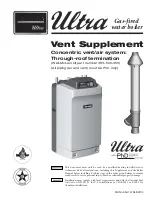
86
Checking for tightness the gas-bearing parts of the gas condensing module
and connections to the fuel cell module under operating pressure
Danger
Escaping gas leads to a risk of explosion.
Check gas equipment (including inside the appli-
ance) for leaks.
Note
Only use suitable and approved leak detection agents
(EN 14291) and devices for the tightness test. Leak
detection agents with unsuitable constituents (e.g.
nitrides, sulphides) can cause material damage.
Remove residues of the leak detection agent after test-
ing.
Checking the combustion quality
Gas condensing module
The electronic combustion controller automatically
ensures optimum combustion quality. During commis-
sioning/maintenance, only the combustion values need
to be checked. For this, measure the CO content and
the CO
2
or O
2
content. For a description of the elec-
tronic combustion controller functions, see page 154.
Note
To prevent operating faults and damage, operate the
appliance with uncontaminated combustion air.
CO content
■
The CO content must be < 1000 ppm for all gas
types.
CO
2
or O
2
content
■
The CO
2
content must be within the following limits
for the lower and upper heating output respectively:
–
7.4 to 9.5 % for natural gas E and LL
■
The O
2
content must be between 4.0 and 7.6 % for
all gas types.
Note
The values apply to operation of the gas condensing
module on its own. In case of parallel operation of the
fuel cell module, lower CO
2
values or higher O
2
values
may occur (purge air).
If the actual CO
2
or O
2
values lie outside their respec-
tive ranges, proceed as follows:
■
Check the balanced flue system for leaks, see
page 77.
■
Check the ionisation electrode, see page 79.
■
Check the connecting cable on the ionisation elec-
trode.
Note
During commissioning, the combustion controller car-
ries out an automatic calibration. Start emissions cap-
ture no sooner than about 60 s after the burner has
started.
Commissioning, inspection, maintenance
Checking the electrical connections for firm seating
5853335
















































